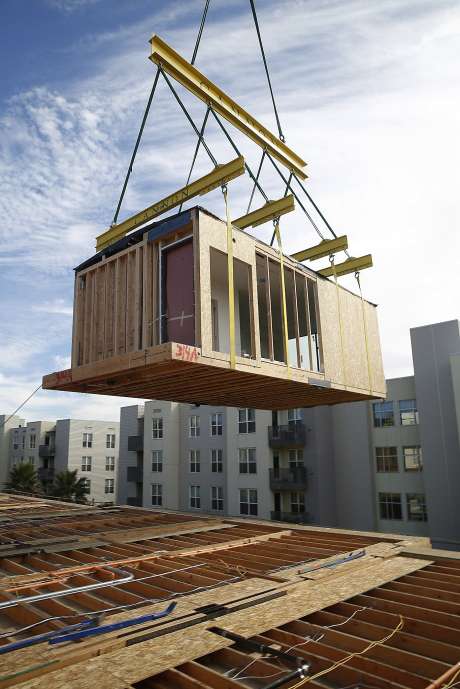Developer, S.F. see new possibilities in assembly-line housing
SF Chronicle
by By J.K. Dineen
October 20, 2016
The 30,000-pound boxes being delivered by a fleet of flatbed trucks to the Bayview don’t look like much. But if you ask Mayor Ed Lee, they just might be a solution to the city’s housing crisis.
On Thursday morning, Lee stood next to a construction trailer at 5830 Third St., talking to developer Rick Holliday and contractor Larry Pace about the 136-unit apartment complex going up there, the biggest modular housing development ever erected in San Francisco.
As they spoke, one of the trucks backed up to the job site, where a custom-designed rigging system — four structural slings hanging from a crane — hoisted the prefabricated module into the air and stacked it like a Lego on top of three floors of similar boxes. That is, if a Lego piece came with a washer and dryer, gas stove and toilet inside it.
“I want you to think about this: Six weeks ago there was nothing here, and now there is a building,” Pace said.
As it turned out, Lee, who has committed to producing or rehabbing 30,000 housing units by 2020, didn’t need much convincing.
“I like what you guys are doing because I want to learn how we can produce housing better, faster and less expensive,” Lee told Holliday and Pace.
Earlier problems
For decades, Holliday, like a lot of urban developers, has been fascinated with the possibility of modular construction, the idea that housing units could be produced more efficiently on an assembly line, like an automobile. But each time he came close to giving it a shot, he would see problems. Around the country, modular projects didn’t turn out well — units were flawed, transportation was difficult, contractors were skeptical. What resulted was often more expensive and of poorer quality than if the structure had been built on site.
“The manufacturers would tell you how wonderful it is, and the developers would always say, ‘It didn’t really work out. I’m not doing a second one,’” Holliday said. “It was the mobile-home industry coming to housing, trying to do more sophisticated infill development, and it wasn’t connecting.”
In wasn’t until 2013 when Patrick Kennedy of Panoramic Interests did a 23-unit building in South of Market, at 28 Harriet St., that Holliday decided to take a closer look. He contacted Zeta Communities in Sacramento, which built the modules for Kennedy’s project, and worked with Sternberg Benjamin Architects and Cannon Constructors on a design in which 314 boxes are pieced together in nine different floor plans. It took two years to come up with a plan.
Soon Pace was a convert as well.
“Two years ago, I was a pessimist. Now I am a poster child,” said Pace. “We can do this and do it in a big way that will benefit everybody in the community.”
More projects planned
Holliday estimates that the project will cost 20 percent less and be built 40 percent faster than conventional construction. One-bedrooms will rent in the $2,000 range, two-bedrooms in the $3,000 range. The project will cost $225,000 per unit, compared with $275,000 using conventional building techniques, Holliday said.
Holliday and Pace don’t plan on stopping there. They have two sites in West Oakland. In addition, Bridge Housing, the affordable housing developer that Holliday founded, is doing a modular project at the San Leandro BART Station.
“We’re doing another one. It’s already planned,” Holliday said. “And I have another one behind that. We are going to demonstrate replicability. I want to make a leap of progress, and this represents it. It’s in San Francisco. It’s in the Bayview. It’s workforce housing. We’ve done it. We’ve learned a lot.”
Seeking factory in S.F.
Holliday says that he could save even more money if he didn’t have to bring the modules in by truck from Sacramento. Lee is working with the Port of San Francisco to find a site where a modular factory could be built. In his conversation with Lee, Holliday estimated that a manufacturing facility large enough to crank out 1,500 to 2,000 units a year could be built for $10 million in eight to 12 months.
For the Third Street project, Cannon came to an agreement with the trade unions that the factory workers would be union and that all the on-site work would be done by union members. Holliday said that an agreement with the Building Trades Council would be a key part of any deal to build a modular factory.
“All the developers want to build housing faster, so this may be a way of doing that,” said Olson Lee, director of the Mayor’s Office of Housing. “These would be wonderful jobs. It would save cost and time. If we can have local workers to support the pipeline of market-rate housing and affordable housing, that would be great for the city.”
Kennedy said he didn’t save anything on construction costs at his Harriet Street project, but by finishing the project eight months faster, he was able to to generate eight extra months of rents. He also ended up with a “higher quality building,” although there were unexpected costs, such as the $75 million policy his insurance company required.
“It turns out that if you drop a 55,000-pound modular on something, bad things are going to come to pass,” he said.
Kennedy would like to do a modular building at 333 12th St., a 246-unit development that is in the planning process. He is looking to take advantage of density bonus legislation that Lee is pushing, which would allow more more density or height, or both, in exchange for making 30 percent of the units below market rate.



